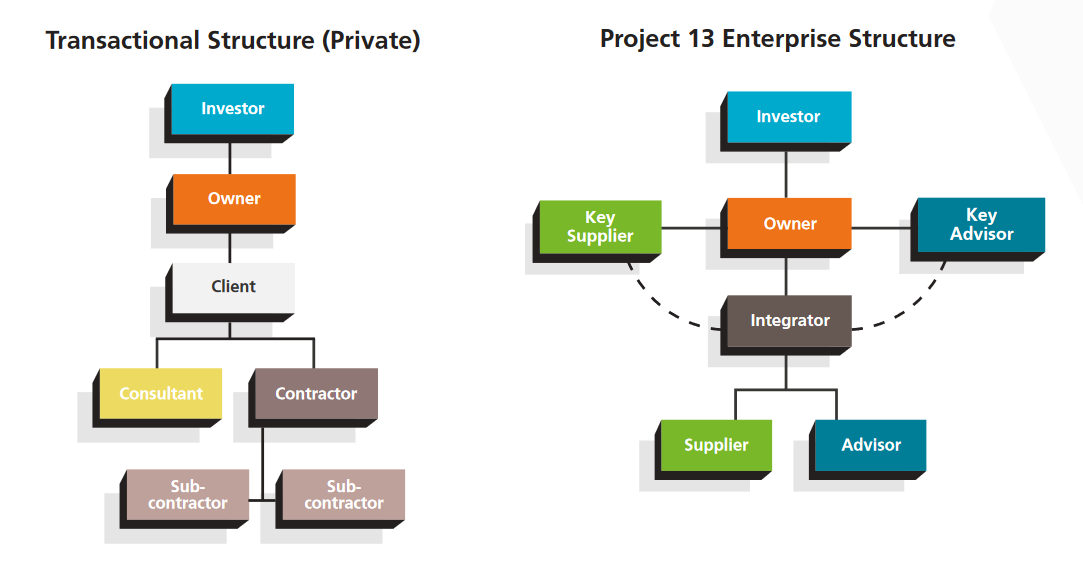Enterprise model for infrastructure
Project 13 is an Institution of Civil Engineers (ICE) - led initiative to boost certainty and productivity in the delivery of infrastructure, to improve whole-life outcomes and to support a more sustainable, innovative, highly-skilled industry. It is a response to a general perception that the infrastructure sector’s current operating model is broken, with projects delivered over budget, over time and below par.
Project 13 proposes an 'enterprise model' rather than a traditional construction programme model in which:
- The owner is central and leads the enterprise, defining long-term value.
- Suppliers and advisors have direct relationships with the owner.
- An ‘integrator’ actively engages and integrates all tiers of the market.
- The key suppliers, owner, advisor and integrator work as one team to optimise value.
ICE suggest that this is different from the traditional construction programme model in that:
- Reward is based on value added to the overall outcomes, not service provided.
- There is a greater understanding of cost drivers and risk across all organisations, with commercial incentives for collaboration to jointly mitigate risk, not transfer it.
- Establishing a high-performing enterprise requires fundamentally different leadership, governance, behaviours and skills to succeed. This is underpinned by organisations with increasingly diverse skills and backgrounds.
In this context, an enterprise is defined as:
‘… an integrated organisation, aligned and commercially incentivised to deliver better outcomes for customers from infrastructure investment. Such organisations are characterised by sophisticated, maturing and typically longer-term relationships between owners, investors, integrators, advisors and suppliers. The roles, capabilities and behaviours of an enterprise differ from those in much of the construction industry today and success will be underpinned by developing organisations with increasingly diverse backgrounds and skill sets.’
The enterprise is led by the owner who manages and operates the asset(s) and leads in identifying the needs of the asset(s) and promoting them to the investor. The investor is an enabler of the enterprise concerned with affordability, societal and financial benefits derived from optimal management of the asset(s).
The owner has a direct relationship with the suppliers and advisors, facilitated by the integrator. The integrator brings in appropriate suppliers and advisors when they can best add value.
The suppliers and advisors are experts in their subject area, accountable for delivery of specific aspects of the enterprise.
Ref: P13 Blueprint, Institution of Civil Engineers, May 2018.
[edit] Find out more
[edit] Related articles on Designing Buildings Wiki
Featured articles and news
One of the most impressive Victorian architects. Book review.
RTPI leader to become new CIOB Chief Executive Officer
Dr Victoria Hills MRTPI, FICE to take over after Caroline Gumble’s departure.
Social and affordable housing, a long term plan for delivery
The “Delivering a Decade of Renewal for Social and Affordable Housing” strategy sets out future path.
A change to adoptive architecture
Effects of global weather warming on architectural detailing, material choice and human interaction.
The proposed publicly owned and backed subsidiary of Homes England, to facilitate new homes.
How big is the problem and what can we do to mitigate the effects?
Overheating guidance and tools for building designers
A number of cool guides to help with the heat.
The UK's Modern Industrial Strategy: A 10 year plan
Previous consultation criticism, current key elements and general support with some persisting reservations.
Building Safety Regulator reforms
New roles, new staff and a new fast track service pave the way for a single construction regulator.
Architectural Technologist CPDs and Communications
CIAT CPD… and how you can do it!
Cooling centres and cool spaces
Managing extreme heat in cities by directing the public to places for heat stress relief and water sources.
Winter gardens: A brief history and warm variations
Extending the season with glass in different forms and terms.
Restoring Great Yarmouth's Winter Gardens
Transforming one of the least sustainable constructions imaginable.
Construction Skills Mission Board launch sector drive
Newly formed government and industry collaboration set strategy for recruiting an additional 100,000 construction workers a year.
New Architects Code comes into effect in September 2025
ARB Architects Code of Conduct and Practice available with ongoing consultation regarding guidance.
Welsh Skills Body (Medr) launches ambitious plan
The new skills body brings together funding and regulation of tertiary education and research for the devolved nation.
Paul Gandy FCIOB announced as next CIOB President
Former Tilbury Douglas CEO takes helm.























